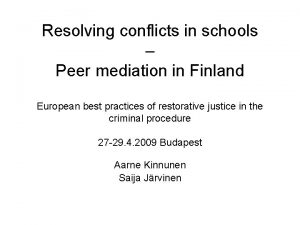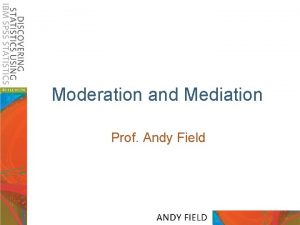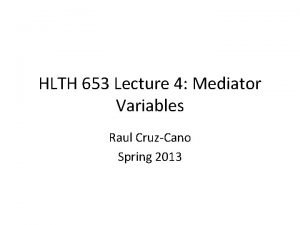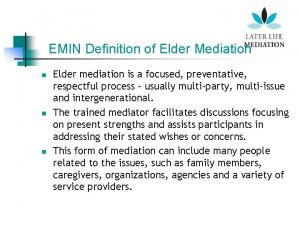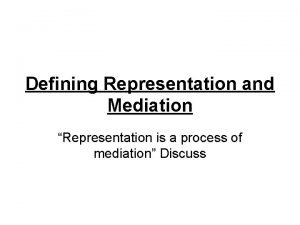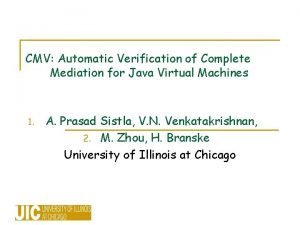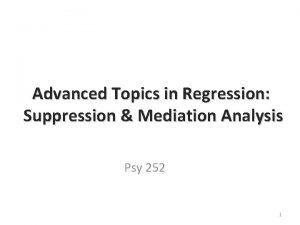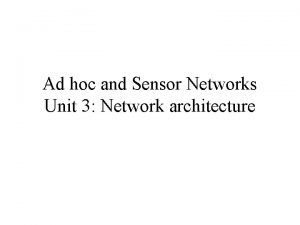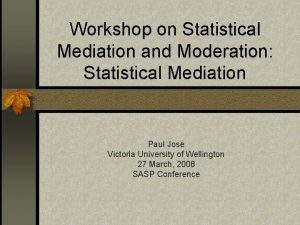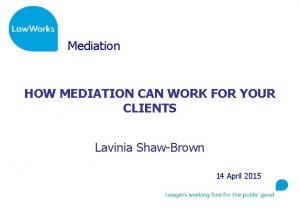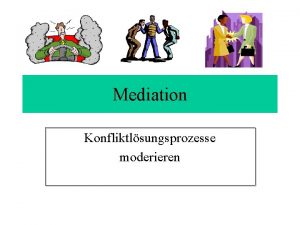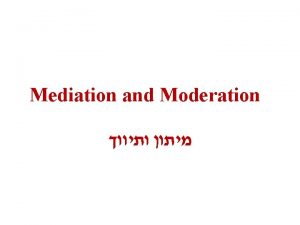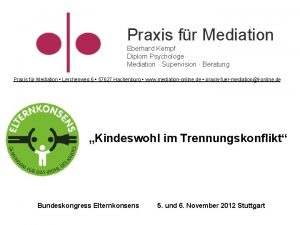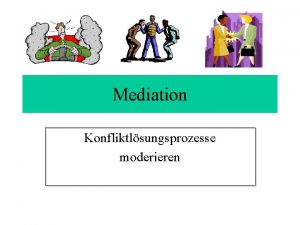Statistical approaches in mediation analysis a comparison of


















- Slides: 18

Statistical approaches in mediation analysis: a comparison of methods for survival data Josef Fritz, Hanno Ulmer Department for Medical Statistics, Informatics and Health Economics, Innsbruck Medical University Contact: josef. fritz@i-med. ac. at, hanno. ulmer@i-med. ac. at

Outline • Mediation / causal inference • Mediation analysis for survival data - Application of methods from Baron&Kenny, Vander. Weele, Lange • Lessons learned from two case studies - Body mass index (BMI) -> coronary heart disease (CHD), mediated by blood pressure, cholesterol, and glucose - Sex/gender -> CHD, mediated by blood pressure, cholesterol, glucose, and smoking - With the use of own data from the Vorarlberg health examination database (VHM&PP)

Motivation (1) • Mediation/causal inference has arrived in the medical literature. • We contributed VHM&PP data to a large meta-analysis: • Recently, the same working group published yet another paper:

Motivation (2) • We are currently investigating the sex – CHD mortality relationship. • With mediators blood pressure (BP), total cholesterol (TC), fasting glucose (FG), smoking status (SS). Sex BP, TC, FG, SS CHD mortality • Paper in submission: Mediation analysis of the relationship between sex/gender, cardiovascular risk factors and mortality from coronary heart disease Josef Fritz, Michael Edlinger, Cecily Kelleher, Susanne Strohmaier, Gabriele Nagel, Hans Concin, Elfriede Ruttmann, Margarethe Hochleitner, Hanno Ulmer

Mediation vs. confounding • Regression analysis allows to estimate the effect of an exposure variable on an outcome variable in the presence of one or more ‘third factors’. • These third factors can operate differently. They can act as confounders, moderators or mediators. • A confounder is associated with the exposure and the outcome. The confounder is not in the causal pathway leading from the exposure to the outcome. • Mediation occurs if factors, like confounders, are associated with the exposure of interest and the outcome, but are in the causal pathway leading from the exposure to the outcome.

Case study 1 – BMI and CHD Red: confounders Blue: mediators • CHD defined as ICD-10 codes I 20 -I 25. • Aim: estimation of direct and indirect path.

Case study 2 – Sex/Gender and CHD Red: confounders Blue: mediators

Mediation analysis Total, direct and indirect effects • For the BMI – CHD example for Cox regression (λ - hazard) • Total effect (TE): • Controlled direct effect (CDE): (M - some fixed mediator level) • Natural direct effect (NDE): • Natural indirect effect (NIE): • It can be shown: TE = NDE x NIE • For CDE no such decomposition exists!

Mediation analysis „Classical“ methods • Aim of mediation analysis: decomposition of total effect into (natural) direct and indirect effect • Classical methods: Baron&Kenny 1986 – 2 -stage regression models – Product method: first model for mediators, second model for outcome including exposure and mediators – Difference method: two models for exposure, one with and one without mediators – Advantage: easy to implement – Drawback: only mathematically consistent in “easy” settings

Mediation analysis „New“ methods • 2 -stage regression models – Refinement of product method with interactions – T. Vander. Weele: Explanation in Causal Inference: Methods for Mediation and Interaction. Oxford University Press 2015. • Weighting based approaches – T. Lange (2014): Assessing natural direct and indirect effects through multiple pathways. Am J Epidemiol. 2014. • Inverse probability based approaches • Applicable for more general settings, but not so easy to implement any more.

Case study 1 – BMI and CHD • Comparison of methods: – Classical product method (Baron&Kenny, 1986) – Classical difference method (Baron&Kenny, 1986) – Regression based approach developed by T. Vander. Weele (refinement of product method) (2011; 2012) – Weighting based approach developed by T. Lange (2014) • Classification of BMI: normal vs. overweight vs. obesity. • Observation: BMI*Age is highly significant in a survival model on CHD. • Therefore, stratification by age group is highly indicated!

Lu et al. (2015): Results 48% 47% 37% 28% 14% 17% 10% 6%

Case study 1 Results overweight vs. normal weight

Case study 1 Results obesity vs. normal weight

Remarks concerning methodology (1) • Methods deliver considerably different results. Interestingly, the new methods of Vander. Weele and Lange often differ quite widely, while the classical methods deliver results in between. • This may be due to: - Strict assumptions (unmeasured confounding) which may be violated. - Classical methods do only deliver approximate results. - The method by Vander. Weele only delivers exact results for “rare” outcomes. - Lange’s method requires non-intertwined pathways.

Case study 2 – Sex/Gender and CHD (1) • In general, men have a higher CHD mortality risk than women, especially at younger ages. • Can the difference in CHD mortality risk between sexes be explained by different risk factor profiles and if yes, how much can be explained? • New mediation approach according to Lange et al. (Am J Epidemiol, 2014). • Allows breakdown of indirect effect into single components for non-intertwined pathways. • Since moderating effect of age, stratification for age groups <50, 50 -64, 65 -74, and ≥ 75 years.

Case study 2 – Sex/Gender and CHD (2) Effect decomposition, Lange et al. 1, 8 1, 6 HR = 4. 65 1, 4 Blood pressure HR = 3. 09 1, 2 Glucose ln(HR) 1, 0 Cholesterol 0, 8 Indirect effect HR = 1. 74 0, 6 Smoking HR = 1. 40 0, 4 Direct effect (not explained by risk factors) 0, 2 0, 0 -0, 2 Age <50 Age 50 -64 Age 65 -74 Age 75+

Remarks concerning methodology (2) • Baron&Kenny: Easy, old, but reliable, product method preferable in survival setting • Vander. Weele: correction for exposure-mediator interaction possible, only for “rare” outcomes. • Lange: computationally intensive, stringent assumptions (nonintertwined pathways), decomposition in single components possible • There is no universally “best” method for all settings. Sensitivity analysis with different methods are recommended.
 A comparison of approaches to large-scale data analysis
A comparison of approaches to large-scale data analysis Limit comparison theorem
Limit comparison theorem Peer mediation definition
Peer mediation definition Billing rating
Billing rating Andy field moderation
Andy field moderation Billing mediation architecture
Billing mediation architecture David kenny mediation
David kenny mediation Moderating vs mediating variable
Moderating vs mediating variable Mediation vs moderation
Mediation vs moderation Mediator vs. moderator variable
Mediator vs. moderator variable Mediation definition
Mediation definition Representational mediation process
Representational mediation process Incomplete mediation in information security
Incomplete mediation in information security Complete mediation example
Complete mediation example Incomplete mediation in information security
Incomplete mediation in information security Steps in the mediation process
Steps in the mediation process Incomplete mediation in information security
Incomplete mediation in information security Mediation hypothesis example
Mediation hypothesis example Mediation device protocol in wsn
Mediation device protocol in wsn


